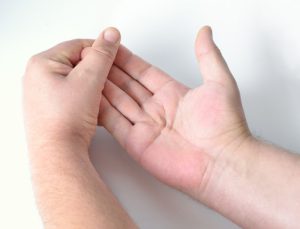Are you experiencing a lump in the palm of your hand that’s getting progressively worse? You might be one of the many individuals who suffer from Dupuytren’s contracture. This condition affects the connective tissue in the hand, leading to the formation of a thick cord that can bend the fingers towards the palm.
Although Dupuytren’s contracture is not life-threatening, it can cause significant discomfort and impair your hand’s function. Fortunately, there are strategies that you can take to reduce your risk of developing this condition.
In this article, we’ll provide an overview of Dupuytren’s contracture and discuss the importance of early intervention and prevention. We’ll also explore various strategies that you can use to reduce your risk of developing this condition, including exercises, diet, and natural treatments.
Dupuytren’s Contracture Treatment Options
Dupuytren’s contracture is a condition that affects the connective tissue in the palm of the hand, causing it to thicken and contract. The result is a visible lump in the palm of the hand that can progress to the point where it affects finger movement. While there is no known cure for Dupuytren’s contracture, there are treatments available that can help manage the condition and reduce the severity of symptoms.
Traditional treatments for Dupuytren’s contracture include surgery and injections of medication to break down the thickened tissue. However, there are also natural treatment options available for those who prefer a more holistic approach. These can include exercises to improve hand mobility, changes to the diet to support tissue health, and the use of supplements and essential oils to reduce inflammation and promote healing.
If you suspect that you may have early-stage Dupuytren’s contracture or have a family history of the condition, it’s important to seek treatment as early as possible. With prompt intervention and a commitment to ongoing management, it’s possible to reduce the impact of Dupuytren’s contracture and maintain hand function for as long as possible.

Dupuytren’s Contracture Prevention Tips
One of the most effective ways to prevent Dupuytren’s contracture is by making lifestyle changes. This includes maintaining a healthy weight, exercising regularly, and avoiding activities that put undue stress on your hands. Additionally, it’s important to monitor your hand health and seek medical attention if you notice any changes in the texture or appearance of your skin.
Another crucial aspect of Dupuytren’s contracture prevention is early intervention. This means seeking treatment as soon as you notice any symptoms of the condition. In some cases, early-stage exercises or physical therapy may be recommended to maintain hand flexibility and strength. You can also incorporate specific nutrients and foods into your diet to support hand health and potentially reduce your risk of developing Dupuytren’s contracture.
By taking proactive steps to prevent Dupuytren’s contracture, you can maintain healthy hand function and minimise the impact of this condition on your daily life.
Hand Contracture Management Strategies
Hand contractures can be a challenging condition to manage, especially if they are related to Dupuytren’s Contracture. One of the best ways to prevent hand contractures is to keep your hands active and moving. This can be achieved through a variety of hand exercises that can help maintain flexibility and mobility in the joints. Hand exercises can also help improve circulation in the hands, which is essential for healthy tissue function and maintenance.
Another important tip for managing hand contractures is to avoid repetitive or strenuous activities that can cause strain on the hands. If you are engaging in activities that require repetitive hand movements, it is important to take breaks and stretch your hands regularly to prevent muscle fatigue and strain.
By incorporating these hand contracture management strategies into your daily routine, you can reduce your risk of developing Dupuytren’s Contracture and other related conditions. Remember, prevention is key when it comes to maintaining healthy hands and preventing hand contractures.
Dupuytren’s Contracture Exercises
If you or someone you know is experiencing symptoms of Dupuytren’s contracture, you may wonder what steps you can take to prevent the condition from worsening. There are strategies you can use to manage symptoms and reduce your risk of further contractures.
One such strategy is to perform exercises to maintain hand flexibility and strength. Early-stage exercises can help to prevent the condition from progressing and can be incorporated into your daily routine. These exercises may include:
- Finger extensions: Straighten your fingers and hold for five seconds before relaxing.
- Fist opens: Slowly open your hand and stretch your fingers as far apart as possible, then relax.
- Thumb stretches: Hold your thumb and gently pull it away from your hand, hold for five seconds and then release.
- Tabletop tapping: Place your hand flat on a tabletop and tap each finger to the surface in turn.
By incorporating these exercises into your daily routine, you can help to maintain hand flexibility and strength, which can slow the progression of Dupuytren’s contracture. Additionally, regular exercise, such as yoga or hand grip exercises, can also help to prevent contractures by keeping the hands flexible and strong.
Remember, it’s important to speak with your healthcare provider before starting any exercise regimen. They can help to create a personalised plan to manage your symptoms and prevent further contractures.

Dupuytren’s Contracture Diet
Research suggests that individuals with a high intake of antioxidants, specifically vitamin C, may have a reduced risk of developing Dupuytren’s contracture. Foods high in vitamin C include citrus fruits, kiwi, strawberries, and bell peppers. Omega-3 fatty acids, found in fatty fish like salmon and tuna, can also reduce inflammation in the body and may help to prevent Dupuytren’s contracture.
On the other hand, consuming high levels of alcohol and sugar may increase your risk of developing the condition. Excessive alcohol consumption can cause inflammation and damage to the connective tissue, while high sugar intake can lead to inflammation and contribute to the development of metabolic disorders that increase the risk of Dupuytren’s contracture.
Maintaining a healthy diet is just one of the many strategies for preventing Dupuytren’s contracture. By incorporating a variety of nutrient-dense foods and avoiding excessive alcohol and sugar intake, you can help reduce your risk of developing this condition and maintain optimal hand health.
Take Control Of Your Health Today!
If you are experiencing symptoms of Dupuytren’s contracture, such as lumps or cords in your palm, it’s crucial to seek help early on. Remember, early intervention is key in managing this condition. If you notice any changes in your hands, such as difficulty with finger movement, don’t hesitate to speak with your healthcare provider.
By reaching out to Dr Stuart Kirkham at the Sydney Orthopaedic Surgeon Clinic for expert guidance and assistance, you can take the necessary steps towards achieving relief and improving your overall well-being. By following these strategies and maintaining a healthy lifestyle, you can take control of your hand health and reduce the risk of Dupuytren’s contracture progression.


